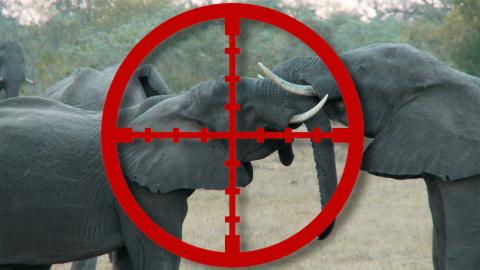Top 10 Controversial or Illegal Animal Hunts

When it comes to hunting, controversy and legality seem to be common topics of discussion. Join http://www.WatchMojo.com as we count down our picks for the Top 10 Controversial or Illegal Animal Hunts.
For this list, we're focusing on animals and animal parts that are outright illegal or considered highly debatable to hunt, as well as trade items of that nature.
Special thanks to our user MikeyP for submitting the idea on our Interactive Suggestion Tool at http://WatchMojo.comsuggest!
#10: Bluefin Tuna
Though a popular food item, this variety of fish has raised its fair share of eyebrows. The multiple bluefin tuna species have been publicly listed as vulnerable after reports of rapid population decline. Their shrinking numbers owed to overfishing, the bluefin is nevertheless continually sought-out... most notably by Japan. 80% of Atlantic and Pacific bluefin tuna is consumed in Japan, where they are served as sushi and sashimi. To make matters worse, bluefin tuna is incredibly valuable in markets, adding to the difficulty of protecting the species.
#9: Foxes
While not a new issue, it’s one that’s warranted some deeper thought as of late. Dating back to the 16th century, fox hunting has long been established as both a traditional sport and as a means of keeping fox populations in line. However, in more recent years controversy has arisen over the need to kill foxes. While some nations have banned the tradition, proponents of fox hunting have argued that foxes spread disease and threaten livestock, necessitating an aggressive response. It’s a debate that hasn’t gotten easier with time.
#8: Tigers
Tigers, known to be an endangered species, have long faced the threat of poaching for multiple reasons. Not only are tigers targeted by big game hunters for prestige, but they are also killed for their skin and bones – the latter of which is used in certain medicines. The increasing threat of extinction has prompted efforts to protect tigers, with organizations like the World Wildlife Fund developing an initiative to double wild tiger populations by 2020.
#7: Sharks and Fins
Sharks, and in particular Great White Sharks, have been driven to vulnerability status by a drop in population. This shift in species stability appears to have been caused by the brutal killing of sharks for their fins, a practice referred to as shark finning. Said fins are often converted into medicine, or served as shark’s fin soup. In response to this trend, the hunting and killing of sharks is strictly banned by several nations, except in cases of self-defence.
#6: Whaling
As it stands, the hunting of whales is heavily debated on an international scale, gaining notable attention after the International Whaling Commission banned commercial whaling in 1986. Issues such as the need for conservation, the cruelty of hunting implements and possible dangers of consuming whale meat have been raised for discussion. However, the continuing poaching of whales for their oil, meat and blubber has made the debate even murkier – and potentially harder to resolve.
#5: Polar Bears
Considered a vulnerable species, polar bears can still be legally hunted – though sport hunters are required to stick to a quota. The continuous hunting of these Arctic-dwelling bears, be it for subsistence or sport, has resulted in key regulations being set by five nations holding ground in the Arctic. While polar bears can pose a threat to settlements in the Far North, critics fear the species could be hunted to extinction.
#4: Lions
Reports have shown a rapid decline in lion populations for the past twenty years. This is due in large part to the threat of poaching, with lions being sought particularly for their bones – an ingredient in natural cures such as lion wine. While widely considered inappropriate to hunt due to their vulnerability as a species, lions are still poached and legally trophy hunted on privately owned game preserves.
#3: Sealing [aka Seal Hunting]
Permitted by eight different countries around the globe, the hunting of seals has become something of a trade in itself. For example, in Canada – where most seal hunting occurs – regulations, hunting quotas and practices are monitored by the nation’s Department of Fisheries and Oceans. However, debate continues to rage regarding various aspects of seal hunting, from how humanely seals are killed, to objections about the harvesting of fur, to even its environmental impact.
#2: Elephants and Ivory Tusks
Elephants have long been targeted for their ivory tusks, once a valuable material used for items such as billiard balls and piano keys. Nowadays, ivory’s value in traditional medicines remains strong on the black market, with elephants suffering from poaching as a result. In fact, the African elephant population dropped from 1.3 million to 600,000 during the ‘80s and ‘90s, forcing governments to make ivory illegalfor trade. And that’s to say nothing of trophy fees charged to hunters in countries where elephant hunting is legal.
Before we unveil our top pick, here are a few honorable mentions:
- Chinese Giant Salamanders
- Monkeys
- Wolf Hunting
- Narwhals
- Turtling
#1: Rhinoceroses and Horns
Poachers seek out rhinoceros primarily for one reason: their pure keratin horns, which are said to be useful as medicine for curing fevers, convulsions, and headaches. Whether or not this is true, the trade of rhino parts in general in strictly prohibited – though hunters are allowed to keep a trophy from legally hunted rhinos. Today, there are only about 5000 black rhinos left in the wild, a number that has been speculated to be tied to the hunting and trade of rhino horns.
Do you agree with our list? What animal hunts do you find controversial? For more intriguing Top 10s published daily, be sure to subscribe to WatchMojo.com.

